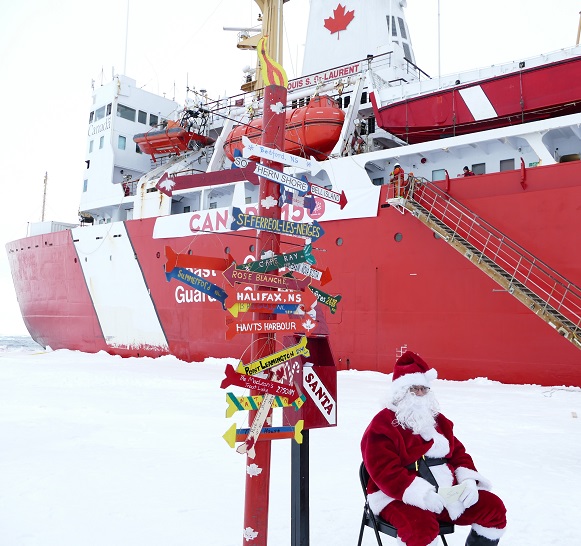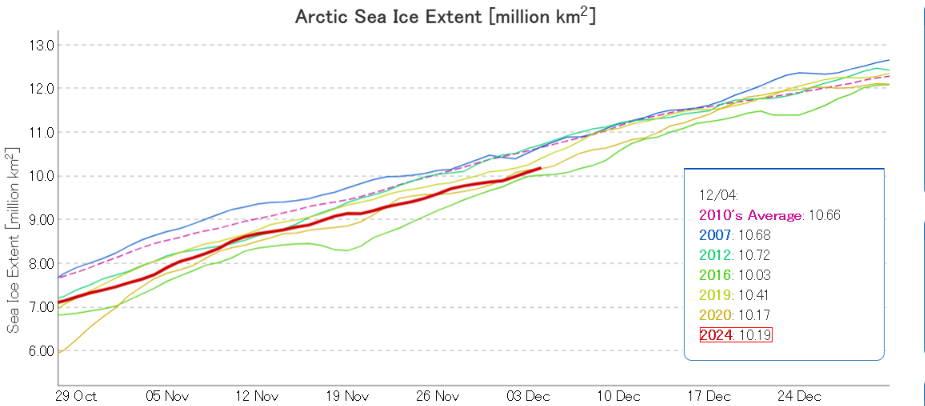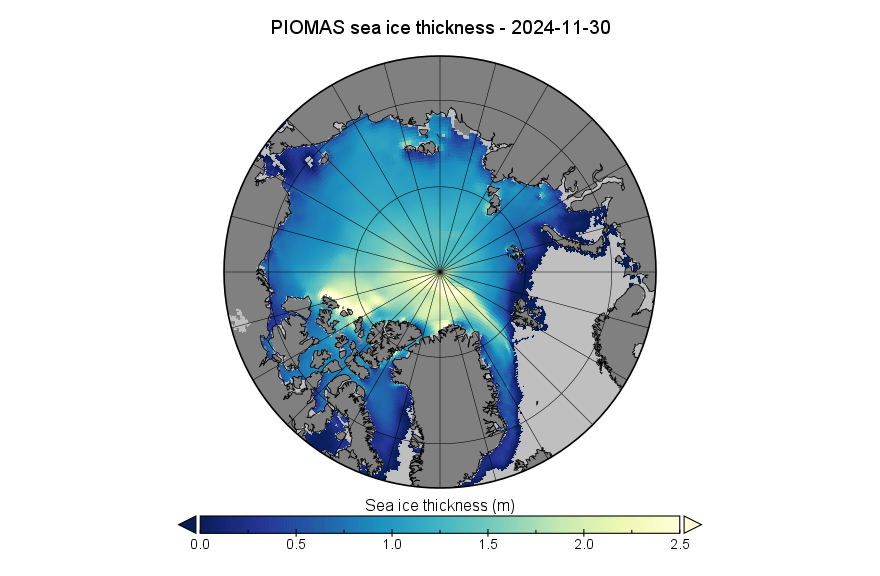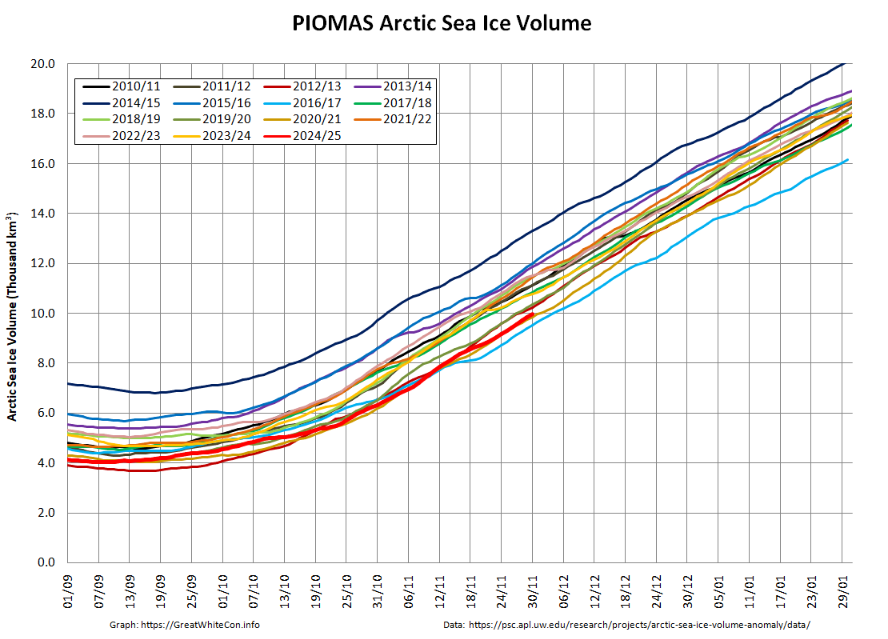| | | Sea level rise is due to land ice melting, not ocean ice. Thermal expansion of sea water is also a factor.
Facts About the Arctic in December 2024
December 5, 2024 News CryoSat-2, DMI, Extent, FDD, JAXA, NSIDC, PIOMAS, SMOS, Thickness, Volume Jim Hunt
Christmas is coming, and even as we speak Snow White is heading for the geographical North Pole to assist Santa’s little helpers in their annual gift delivery mission:
 Santa at the North Pole in August 2016 Santa at the North Pole in August 2016
We’ll start the festive season with a graph of JAXA/ViSHOP extent, which is in a “statistical tie” with 2020 for 2nd lowest for the date in the satellite era:

Here’s the PIOMAS gridded thickness data for the end of November 2024:

On November 30th Arctic sea ice volume had increased to 9.99 thousand km³, 3rd lowest for the date in the PIOMAS record:

For comparison purposes, here is the “near real time” CryoSat-2/SMOS merged thickness data from the Alfred Wegener Institute:
Continue reading Facts About the Arctic in December 2024? Facts About the Arctic in December 2024
December 5, 2024 News CryoSat-2, DMI, Extent, FDD, JAXA, NSIDC, PIOMAS, SMOS, Thickness, Volume Jim Hunt
Christmas is coming, and even as we speak Snow White is heading for the geographical North Pole to assist Santa’s little helpers in their annual gift delivery mission:
 Santa at the North Pole in August 2016 Santa at the North Pole in August 2016
We’ll start the festive season with a graph of JAXA/ViSHOP extent, which is in a “statistical tie” with 2020 for 2nd lowest for the date in the satellite era:

Here’s the PIOMAS gridded thickness data for the end of November 2024:

On November 30th Arctic sea ice volume had increased to 9.99 thousand km³, 3rd lowest for the date in the PIOMAS record:

For comparison purposes, here is the “near real time” CryoSat-2/SMOS merged thickness data from the Alfred Wegener Institute:
Continue reading Facts About the Arctic in December 2024?
==
The 2024 Arctic Sea Ice Minimum Extent in the Cryodenialosphere | The Great White Con
September 24, 2024
Earlier today the National Snow and Ice Data Center announced that:
On September 11, Arctic sea ice likely reached its annual minimum extent of 4.28 million square kilometers (1.65 million square miles). The 2024 minimum is the seventh lowest in the nearly 46-year satellite record. The last 18 years, from 2007 to 2024, are the lowest 18 sea ice extents in the satellite record…
Note that this is a preliminary announcement. Changing winds or late-season melt could still reduce the Arctic ice extent, as happened in 2005 and 2010. NSIDC scientists will release a full analysis of the Arctic melt season, and discuss the Antarctic winter sea ice growth, in early October.
Consequently several of the usual cryodenialospheric suspects have been frantically spinning their webs of deceit around the announcement.
First up was Javier Vinós, who beat the NSIDC’s starting gun by firing a broadside on X (formerly Twitter) on Sunday. If you’re unfamiliar with the name, Javier frequently pontificates about Arctic sea ice, amongst other things, on Judith Curry’s “Climate Etc.” blog. He confidently announced that:
Arctic sea ice reaches its annual minimum with an extent greater than in 2007, 2012, 2016, 2019, 2020 and 2023.
The two warmest years in a row at > +1.5°C have ZERO IMPACT on the 17-year resilience of Arctic sea ice.
Needless to say, “Snow White” felt compelled to quibble:
twitter.com
Following which Javier valiantly decided to dig himself into an ever deeper hole, after proudly supporting his alleged “case” by presenting me with a learned journal article I’m already writing about in a draft blog post of my own:

Following the NSIDC’s announcement today, Anthony Watts hastily copied an evidently even more hastily produced article by Paul Homewood, which opened with this graphic graphic dated September 7th:

continues
--
Facts About the Arctic in December 2024
December 5, 2024
Christmas is coming, and even as we speak Snow White is heading for the geographical North Pole to assist Santa’s little helpers in their annual gift delivery mission:

Santa at the North Pole in August 2016
We’ll start the festive season with a graph of JAXA/ViSHOP extent, which is in a “statistical tie” with 2020 for 2nd lowest for the date in the satellite era:

Here’s the PIOMAS gridded thickness data for the end of November 2024:

On November 30th Arctic sea ice volume had increased to 9.99 thousand km³, 3rd lowest for the date in the PIOMAS record:

For comparison purposes, here is the “near real time” CryoSat-2/SMOS merged thickness data from the Alfred Wegener Institute:
Continue reading Facts About the Arctic in December 2024? |
|










